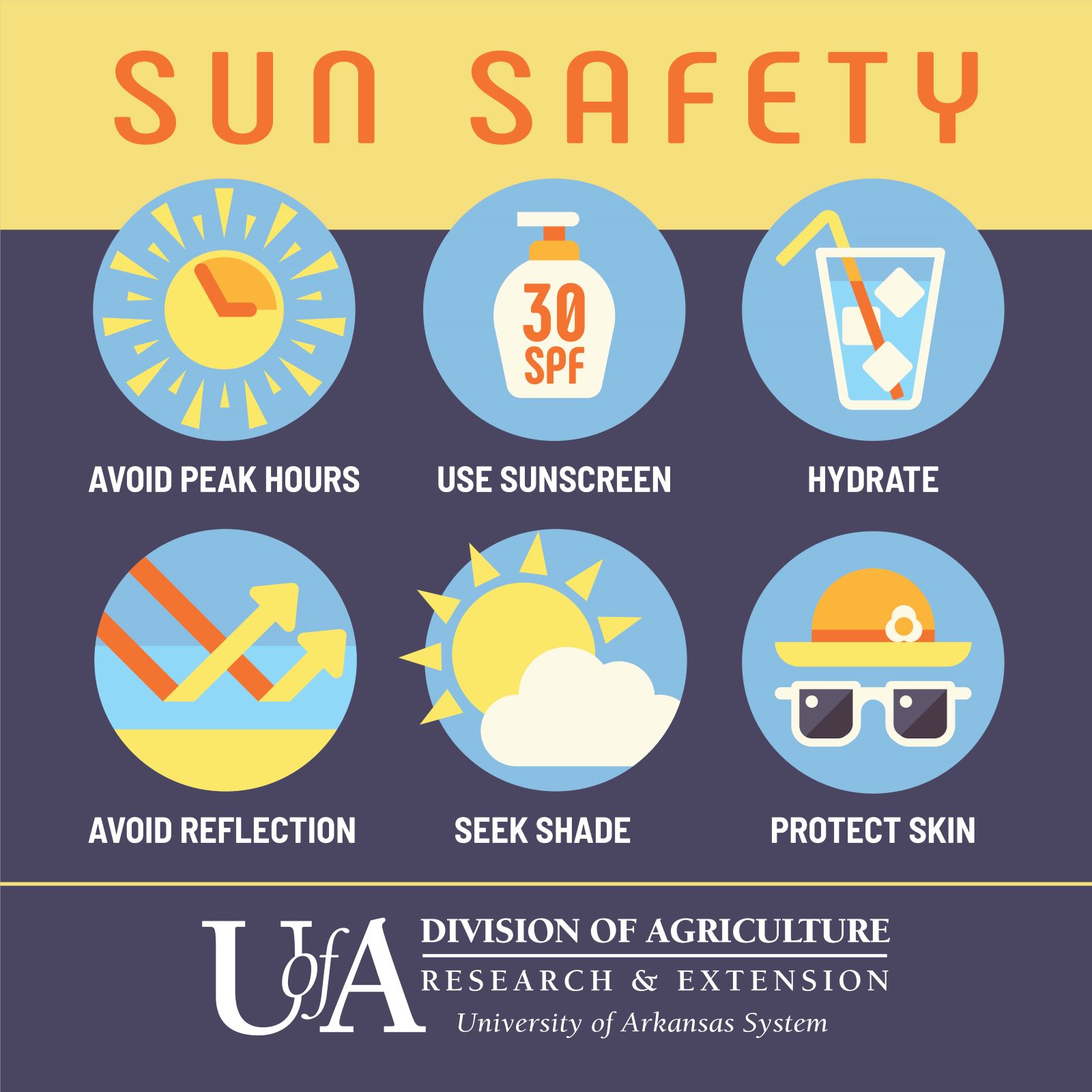Practice caution to prevent heat-related illness
By Rebekah Hall
U of A System Division of Agriculture
July 24, 2024
Fast Facts:
- Heat and sun exposure, lack of hydration precursors to illness
- Risks of heat stroke, exhaustion, rash, cramps and sunburn
- Be cautious when heat, humidity higher than average for geographic area
(626 words)
(Newsrooms: With art)
LITTLE ROCK — With summer 2024 on track to be the hottest summer on record for many cities in the U.S., it’s important to follow heat safety guidelines to prevent sunburns, heat exhaustion and heat stroke.
Bryan Mader, extension assistant professor of health for the University of Arkansas System Division of Agriculture, said people should practice caution when temperatures reach above average highs for their specific region.
“While there is not a specific temperature — such as 100 degrees Fahrenheit — at which we should be more concerned than another, a simple way to think about being extra cautious around heat is when temperatures and humidity are above average for a given geographic area,” Mader said. “Because some places are hotter than others, this depends on what’s considered average for a particular location at that time of year. Humid and muggy conditions can make it seem hotter than it really is.”
Heat-related illnesses are preventable if precautions are taken, Mader said. These illnesses, such as heat exhaustion or heat stroke, occur when the body is not able to properly cool itself.
“While the body normally cools itself by sweating, during extreme heat, this might not be enough,” Mader said. “In some cases, a person’s body temperature rises faster than it can cool itself down. This can cause damage to the brain and other vital organs.”
Though everyone is susceptible to heat-related illness, Mader said there are special populations who should take extra caution during heat exposure. Those at increased risk include adults 65 and older, infants and children, pregnant women and people with chronic illnesses such as heart disease or cancer. People without access to air conditioning, athletes and outdoor workers are also at a higher risk.
Signs of heat-related illness
- Heat stroke: A high body temperature greater than 103 F; hot, red or dry skin; fast pulse; dizziness, nausea, confusion and loss of consciousness.
- Heat exhaustion: Heavy sweating; cold, pale and clammy skin; fast, weak pulse; nausea or vomiting; muscle cramps, tiredness or weakness; dizziness; headache and fainting.
- Heat cramps: Heavy sweating during intense exercise; muscle pain or spasms.
- Heat rash: Red clusters of small blisters that look like pimples on the skin, usually on the neck, chest, groin, elbows or on the anterior side of arms.
Heat-related illness prevention tips
- Wear lightweight, loose-fitting clothes to improve airflow and aid in natural cooling.
- Stay indoors when able, and avoid using appliances that give off heat.
- Do not leave children, or anyone else, in cars unattended. Double check all the seats in your vehicle before walking away.
- Schedule outdoor activities with a plan in place. Try to limit outdoor activities during the hottest parts of the day. Rest, often, in shaded areas to limit heat exposure.
- Wear sunscreen to protect your skin, and wear hats, long sleeves and pants when able, and when it does not restrict your movements or your ability to sweat naturally.
- Drink plenty of fluids, and do not consume sugary or alcoholic beverages when you are in the heat.
- Replace salts and minerals, such as electrolytes, frequently during heat exposure. Sweating eliminates electrolytes, which can be replaced using a sports drink, or another source for replenishing minerals.
- Stay informed about changes in the weather, especially related to extreme temperatures, humidity and UV exposure.
- Use a buddy system, especially for outdoor workers or athletes, to ensure safety.
- Check on those who are at high risk, especially if they do not have air conditioning in their home or place of employment.
Mader said that while working in the heat, it is recommended to drink at least 8 ounces of water every 15-20 minutes. This translates to approximately 24-32 ounces per hour of heat exposure.
For more information about healthy living, visit the Cooperative Extension Service’s Health in Arkansas website.
To learn about extension programs in Arkansas, contact your local Cooperative Extension Service agent or visit www.uaex.uada.edu. Follow us on X and Instagram at @AR_Extension. To learn more about Division of Agriculture research, visit the Arkansas Agricultural Experiment Station website: https://aaes.uada.edu. Follow on X at @ArkAgResearch. To learn more about the Division of Agriculture, visit https://uada.edu/. Follow us on X at @AgInArk.
About the Division of Agriculture
The University of Arkansas System Division of Agriculture’s mission is to strengthen agriculture, communities, and families by connecting trusted research to the adoption of best practices. Through the Agricultural Experiment Station and the Cooperative Extension Service, the Division of Agriculture conducts research and extension work within the nation’s historic land grant education system.
The Division of Agriculture is one of 20 entities within the University of Arkansas System. It has offices in all 75 counties in Arkansas and faculty on five system campuses.
Pursuant to 7 CFR § 15.3, the University of Arkansas System Division of Agriculture offers all its Extension and Research programs and services (including employment) without regard to race, color, sex, national origin, religion, age, disability, marital or veteran status, genetic information, sexual preference, pregnancy or any other legally protected status, and is an equal opportunity institution.
# # #
Media Contact:
Rebekah Hall
rkhall@uada.edu
@RKHall_
501-671-2061
